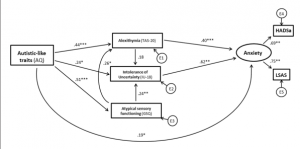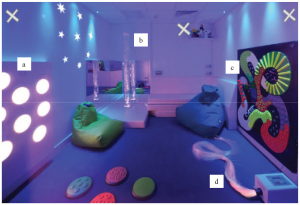研究文章
资源中心收集了大量的文章供读者参考
教务处组织的数字教材建设与应用实践专题讲座,为教师们提供了宝贵的学习和交流机会,推动了数字教材的发展与创新。
教务处组织的数字教材建设与应用实践专题讲座,为教师们提供了宝贵的学习和交流机会,推动了数字教材的发展与创新。
Lindsay L. Shea, Mi‑Yeet Wong, Wei Song, Katy Kaplan, Disha Uppal, Mark S. Salzer
Abstract
Peer support has been an undeveloped pathway for filling the service gap and to generate employment opportunities for autistic individuals. Peer supports have been deployed widely in mental health and among veterans and understanding the utility of this service modality among autistic individuals illuminates opportunities for research, policy, and practice. This study examined characteristics of participants in an autistic-delivered peer support program and reports on use of and satisfaction with the program. Half of autistic participants had a co-occurring mental health diagnosis. Participants reported multiple areas of unmet needs and participant satisfaction with the program was high (90%). The findings of this study point toward autistic-delivered peer support as a promising avenue for future development.
同伴支持一直是弥补服务差距和为孤独症人群创造就业机会的一条尚未开发的途径。同伴支持已经在心理健康和退伍军人中广泛部署并了解其效用这种服务模式在孤独症个体中的应用为研究、政策和实践提供了机会。这项研究调查孤独症患者同伴支持计划参与者的特征,并报告其使用情况和满意度和程序一起。一半的孤独症参与者同时患有精神健康疾病。参与者报告了多个未满足需求的领域和参与者对计划的满意度很高(90%)。这项研究的发现指向孤独症患者提供的同伴支持是未来发展的一条有希望的途径。
图1:CAPS(i.e. the Community Autism Peer Specialist)发展过程

图2:CAPS概念框架

Saskia Riedelbauch, Sebastian B Gaigg, Tobias Thiel, Veit Roessner and Melanie Ring
Abstract
Anxiety disorders commonly occur in autism. Existing studies implicate intolerance of uncertainty, alexithymia, sensory processing differences and emotion regulation difficulties as influencing factors of anxiety in autism. To date, a few studies have considered the combination of these factors within the same sample. This study used structural equation modelling to test the prediction that intolerance of uncertainty and emotion regulation constitute more direct causes of anxiety in autism that mediate the influences of sensory processing difference and alexithymia as more sequential contributing factors. Autistic (n=86) and non-autistic adults (n=100) completed a battery of self-report questionnaires. Only when applied to each group separately, the broad predictions of the model were confirmed for the autistic group following data-driven additions of paths between sensory processing difference and anxiety and alexithymia implying that sensory processing difference contribute indirectly as well as directly to individual differences in anxiety. For the non-autistic group, model fit could only be achieved after removing autism-related traits and sensory processing differences as predictors of anxiety. These results suggest that aetiology and expression of anxiety in autism partially overlap with what is observed in the general population except that sensory processing differences appear to play a relatively unique role in the context of autism.
孤独症患者常有焦虑。现有研究表明,不确定性不耐受、述情障碍、感觉加工差异和情绪调节困难是孤独症焦虑的影响因素。迄今为止,一些研究考虑了同一样本中这些因素的组合。这项研究使用结构方程模型来测试对不确定性的不容忍和情绪调节构成自闭症焦虑的更直接原因的预测,这些因素介导了感觉加工差异和述情障碍作为更连续的影响因素的影响。孤独症患者(86人)和非孤独症患者(100人)完成了一系列自我报告问卷。只有当分别应用于每一组时,该模型的广泛预测才在自闭症组中得到证实,这是因为数据驱动了感觉处理差异与焦虑和述情障碍之间的路径的增加,这表明感觉处理差异间接和直接导致了焦虑的个体差异。对于非孤独症组,模型拟合只能在去除与孤独症相关的特质和感觉处理差异作为焦虑的预测因素后才能实现。这些结果表明,孤独症的病因和焦虑表现与在普通人群中观察到的部分重叠,只是感觉加工差异似乎在孤独症的背景下发挥了相对独特的作用。
Lay abstract
Anxiety disorders are common in autism. Research studies have identified factors that influence anxiety in autism, such as difficulties with uncertain situations, difficulties understanding own emotions, differences in processing sensory input (related to our senses) and difficulties regulating emotions. To date, a few studies have considered the combination of these factors within the same sample. This study used structural equation modelling to test the contribution of these factors in autism. Autistic (n=86) and non-autistic adults (n=100) completed a battery of self-report questionnaires.
Only when applied to each group separately, the broad predictions of the model were confirmed for the autistic group. The model confirmed that difficulties with uncertain situations and in regulating emotions play a central role in anxiety in autism. Difficulties understanding own emotions and differences in processing sensory input both contribute to anxiety indirectly through their respective interrelation with the other two factors (difficulties with uncertain situations and in regulating emotions). Importantly, the results imply that sensory processing differences contribute not only indirectly but also directly to individual differences in anxiety. For the non-autistic group, model fit could only be achieved after removing autism-related traits and sensory processing differences as predictors of anxiety. These results suggest that cause/development and expression of anxiety in autism partially overlap with what is observed in the general population except that sensory processing differences appear to play a relatively unique role in the context of autism.
焦虑在孤独症群体中很常见。研究已经确定了影响孤独症患者焦虑的因素,例如不确定情况下的困难、理解自己情绪的困难、处理感官输入(与我们的感官有关)的差异以及调节情绪的困难。迄今为止,一些研究考虑了同一样本中这些因素的组合。这项研究使用结构方程模型来测试这些因素在孤独症中的作用。孤独症患者(86人)和非自闭症患者(100人)完成了一系列自我报告问卷。只有当分别应用于每个群体时,该模型的广泛预测才在自闭症群体中得到证实。该模型证实,在不确定的情况下和调节情绪方面的困难在孤独症患者的焦虑中起着核心作用。理解自己情绪的困难和处理感觉输入的差异都通过它们与其他两个因素(不确定情况和调节情绪的困难)的相互关系间接导致焦虑。重要的是,研究结果表明感觉加工差异不仅间接而且直接导致了焦虑的个体差异。对于非孤独症组,模型拟合只能在去除与孤独症相关的特质和感觉处理差异作为焦虑的预测因素后才能实现。这些结果表明,孤独症患者焦虑的原因/发展和表达与普通人群中观察到的部分重叠,只是感觉加工差异似乎在自闭症的背景下发挥了相对独特的作用。
图1:结构方程建模结果(孤独症群体)

图2:结构方程建模结果(非孤独症群体)

(IF:5.2)
Katy L Unwin, Georgina Powell, Catherine RG Jones
Abstract
Multi-sensory environments are widely used with autistic children. However, there are no data on how autistic children choose to spend time in the room and how this relates to their sensory, behavioural and intellectual profiles. We observed the frequency and duration of visits to multi-sensory environment equipment of 41 autistic children during 5 min of free play. At a group level, the bubble tube and touch, sound and light board were both highly popular, with the fibre optics and tactile board receiving less attention. Sensory seeking behaviours were more commonly observed in the multi-sensory environment than sensory-defensive behaviours. We found that observed sensory seeking behaviours, along with parent-reported sensory behaviours and non-verbal intelligence quotient, were associated with specific patterns of multi-sensory environment equipment use, but broader autistic behaviours were not. These data suggest that the multi-sensory environment equipment preferences of autistic children are related to individual differences in sensory behaviour and non-verbal intelligence quotient. This information has the potential to inform the development of best-practice multi-sensory environment guidelines that focus on individual needs.
多感官环境广泛用于孤独症儿童。然而,没有关于孤独症儿童如何选择在房间里度过时间以及这与他们的感官、行为和智力特征有何关系的数据。我们观察了 41 名孤独症儿童在5分钟的自由游戏中访问多感官环境设备的频率和持续时间。在群体层面上,气泡管和触摸、声音和光板都非常受欢迎,而光纤和触觉板则较少受到关注。在多感官环境中,感官寻求行为比感官防御行为更常见。我们发现,观察到的感官寻求行为,以及父母报告的感官行为和非语言智力商数,与多感官环境设备使用的特定模式有关,但更广泛的孤独症行为则不然。这些数据表明,孤独症儿童的多感官环境设备偏好与感官行为和非语言智商的个体差异有关。这些信息有可能为制定专注于个人需求的最佳实践多感官环境指南提供信息。
Lay abstract
Multi-sensory environments, often called sensory rooms, are widely used with autistic children. However, we know very little about how autistic children choose to spend their time in multi-sensory environments. We also do not know how their equipment preferences relate to their individual characteristics such as their sensory differences, level of ability or general autistic behaviours. We measured the frequency and duration of visits to multi-sensory environment equipment of 41 autistic children during 5 min of free play. The bubble tube and touch, sound and light board were both highly popular, with the fibre optics and tactile board receiving less attention. The children displayed significantly more sensory seeking behaviours in the multi-sensory environment than sensory-defensive behaviours. These sensory seeking behaviours, as well as the sensory behaviours that their parents reported they showed in daily life, were associated with specific patterns of multi-sensory environment equipment use. Non-verbal ability was also associated with multi-sensory environment equipment use, but broader autistic behaviours were not. Our findings show that the multi-sensory environment equipment preferences of autistic children are related to individual differences in sensory behaviours and non-verbal ability. This information could be useful for teachers and other practitioners who want to know how best to use multi-sensory environments with autistic children.
多感官环境,通常称为感官室,广泛用于孤独症儿童。然而,我们对孤独症儿童如何选择在多感官环境中度过时间知之甚少。我们也不知道他们的设备偏好如何与他们的个人特征相关,例如他们的感官差异、能力水平或一般自闭症行为。我们测量了 41 名孤独症儿童在 5 分钟的自由游戏中访问多感官环境设备的频率和持续时间。气泡管和触控板、声音板和光板都非常受欢迎,而光纤和触觉板则较少受到关注。儿童在多感官环境中表现出比感官防御行为更多的感官寻求行为。这些感官寻求行为,以及他们的父母报告他们在日常生活中表现出的感官行为,都与多感官环境设备使用的特定模式有关。非语言能力也与多感官环境设备的使用有关,但更广泛的孤独症行为则不然。我们的研究结果表明,孤独症儿童的多感官环境设备偏好与感官行为和非语言能力的个体差异有关。这些信息对于想知道如何最好地与孤独症儿童使用多感官环境的教师和其他从业者可能很有用。
图1:多感官环境的图像
包括(a)触摸,声光板,(b)气泡管,(c)触觉板和(d)光纤。“X”标记摄像机定位,所有摄像机都指向外和向下。

Eapen V, Islam R, Azim S I, et al. Factors impacting parental quality of life in preschool children on the Autism Spectrum[J]. Journal of Autism and Developmental Disorders, 2022: 1-12.
Abstract
This study examined connections between parental quality of life (QoL) and features of children (autism severity, cognitive ability, behavioral profile, and sociodemographic factors). Parents of 97 children attending an autism-specific preschool completed the Quality of Life in Autism, Vineland Adaptive Behavior Scales and Child Behavior Checklist. The Autism Diagnostic Observation Schedule and Mullen Scales of Early Learning were also administered. Reduced restrictive/repetitive behavior and higher socialization and play/leisure scores were associated with better parental QoL. Better behavioral regulation and attention also predicted better QoL, as did stronger communication and reduced internalising behaviours. Findings indicate that a child’s level of autism specific traits, adaptive functioning and behavioral profile has greater impact on parental QoL than cognitive level.
本研究考察了父母生活质量(Q0L)与儿童特征(自闭症严重程度、认知能力、行为特征和社会人口因素)之间的联系。 97名自闭症儿童的父母完成了自闭症儿童的生活质量、Vimneland适应行为量表和儿童行为检查表。 同时使用自闭症诊断观察表和马伦早期学习量表。 限制性/重复性行为的减少、社会化和游戏/休闲得分的提高与更好的父母生活质量有关。 更好的行为规范和注意力也预示着更好的生活质量,更强的沟通和更少的内化行为也是如此。 结果表明,儿童自闭症特征水平、适应功能水平和行为特征水平对父母生活质量的影响大于认知水平。
Krieger B, Moser A, Morgenthaler T, et al. Parents’ perceptions: environments and the contextual strategies of parents to support the participation of children and adolescents with autism spectrum disorder—a descriptive population-based study from Switzerland[J]. Journal of Autism and Developmental Disorders, 2022: 1-23.
Abstract
Environments have a modifying effect on the participation of children and adolescents with autism spectrum disorder (ASD) in all areas of life. This cross-sectional study investigated parental perspectives on supportive or hindering environments and the daily contextual strategies parents used to enhance their children’s participation. Qualitative and quantitative data gathered from 115 parents from German-speaking Switzerland using the participation and environment measure-child and youth (PEM-CY) were analyzed. Results revealed 45 environmental supports and barriers at home, at school, and in the community. Contextual strategies were identified in combination with people, activities, time, objects, and places. Parental perspectives on participation and their contextual strategies should be considered in environmental-based interventions to support the participation of children and adolescents with ASD.
环境对患有自闭症谱系障碍(ASD)的儿童和青少年在生活的各个领域的参与都有调节作用。 本横断面研究调查了父母对支持性或阻碍性环境的看法,以及父母用于提高孩子参与的日常情境策略。 使用参与和环境测量-儿童和青年量表(PEM-CY)对来自瑞士德语区的115名家长收集的定性和定量数据进行了分析。结果显示,在家庭、学校和社区中存在45种环境支持和障碍。 语境策略与人、活动、时间、物体和地点相结合。在以环境为基础的干预措施中,应考虑家长对参与的看法及其情境策略,以支持自闭症儿童和青少年参与。
Schuck R K, Dwyer P, Baiden K M P, et al. Social validity of pivotal response treatment for young autistic children: Perspectives of autistic adults[J]. Journal of Autism and Developmental Disorders, 2022: 1-19.
Abstract
The social validity of autism behavioral intervention has been questioned. Naturalistic Developmental Behavioral Interventions (NDBIs) attempt to address some concerns, but it is unclear whether autistic people consider NDBIs socially valid. Social validity of an NDBI, Pivotal Response Treatment (PRT), was investigated through autistic adults commenting on videos of autistic children receiving PRT. Qualitative coding of responses generated three themes: respect for individuals; assessment of intervention implementation; and socioemotional considerations. Although video brevity limits the scope of the present study’s conclusions, participants highlighted PRT components that appeared socially valid (e.g., reinforcing attempts, following the child’s lead) and aspects appearing invalid (e.g., overemphasis on spoken language). Therefore, adjustments appear necessary for PRT to be fully acceptable to the autistic community.
自闭症行为干预的社会有效性一直受到质疑。 自然发展行为干预(NDBIS)试图解决一些问题,但尚不清楚自闭症患者是否认为NDBI具有社会有效性。 通过自闭症成人对自闭症儿童接受关键反应治疗视频的评论,对NDBI的社会效度进行了调査。 定性编码反应产生三个主题:尊重个人;干预措施实施评估;以及社会情感方面的考虑。 尽管视频的简短性限制了本研究结论的范围,但参与者强调了PRT在社会上有效的部分(例如,加强尝试,跟随孩子的领导)和无效的方面(例如,过度强调口语)。因此,有必要对PRT进行调整,使其完全为自闭症群体所接受。
浙江省杭州市萧山区耕文路1108号
0571-86933421
info@nsercasd.cn
周一至周五: 8:00-19:00
周六: 8:00-14:00
周日: 休息
